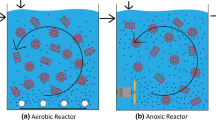Abstract
To remove hydrogen sulfide biologically, a three phase fluidized bed bioreactor was used in whichThiobacillus sp.IW was immobilized on biosands. The optimum operating condition of the bioreactor was found to be 30 ‡C, pH 7, bed height of 0.85–1.0 m and aspect ratio of 1.0. At these conditions, the bioreactor removed more than 88 % of the hydrogen sulfide for an inlet concentration of 30–160 ppm and a gas flow rate of 2–5 Z/m. The maximum removal rate obtained was about 1,000 mg H2S/min. In continuous operation of the bioreactor, the removal efficiency remained at 99 % for up to 16 hours and decreased to 91 % at 52 hours.
Similar content being viewed by others
References
Barth, C. L., Elliott, F. L. and Melvin, S.W., “Using Odour Control Technology to Support Animal Agriculture”,Trans ASCE,27, 859 (1984).
Brock, T. D. and Madigan, M. T., “Biology of Microorganisms”, 6th Ed., Prentice-Hall, Englewood Cliffs, New Jersey, 1991.
Cha, J.-M., Park, Y. and Lee, I.-W., “Effect of Cultivation Condition on Growth of the Hydrogen Sulfide-DegradingThiobacillus sp.IW Isolated from Waste Coal Mine Water”,Kor. J. Biotechnol. Bioeng.,9, 287 (1994).
Chang, C. H. and Shin, N. C., “The Engineering of Odor Control”, Dong Wha, Seoul, 1993.
Cho, K.-S., Zang, L., Hirai, M. and Shoda, M., “Removal Characteristics of Hydrogen Sulfide and Methanethiol byThiobacillus Sp. Isolated from Peat in Biological Deodourisation”,J. Ferment. Bioeng.,71, 44 (1991).
Chung, Y.-C, Huang, C. and Tseng, C.-P., “Biodegradation of Hydrogen Sulfide by a Laboratory-Scale ImmobilizedPseudomonas putida CH11 Biofilter”,Biotechnol. Prog.,12, 773 (1996).
Chung, Y.-C, Huang, C. and Tseng, C.-P., “Kinetics of Hydrogen Sulfide Oxidation by Immobilized Autotrophic and Heterotrophic Bacteria in Bioreactors”,Biotechnol. Tech.,10, 743 (1996).
Huang, C, Chung, Y.-C. and Hsu, B.-M., “Hydrogen Sulfide Removal by Immobilized Autotrophic and Heterotrophic Bacteria in the Bioreactors”,Biotechnol. Tech.,10, 595 (1996).
Janssen, A. J. H., Ma, S. C., Lens, P. and Lettinga, G., “Performance of a Sulfide-Oxidizing Expanded-Bed Reactor Supplied with Dissolved Oxygen”,Biotechnol Bioeng.,53, 32 (1996).
Kim, B. W. and Chang, H. N., “Removal of Hydrogen Sulfide byChlorobium thiosulfatophilum in Immobilized-Cell and Sulfur-Settling Free-Cell Recycle Reactors”,Biotechnol. Prog.,7, 495 (1991).
Kim, S., “A Study on Immobilization Characteristics ofThiobacillus Sp.IW on Activated Carbon”, Masters Thesis, Pusan National University, 1996.
Kim S. M., Oh, K. H. and Kim, D., “The Immobilization Characteristics ofThiobacillus Sp.IW”,Kor. J. Biotechnol Bioeng.,11, 78 (1996).
Kusai, K. and Yamanaka, T., “The Oxidation Mechanisms of Thiosulphate and Sulphide inChlorobium thiosulfatophilum”,Biochim. Biophys. Acta,325, 304 (1973).
Ryu, H. W., “Microbial Desulphurisation of a Bituminous Coal by Iron-Oxidizing BacteriaThiobacillus ferrooxidans”,K. J. Biotechnol. Bioeng.,11, 238 (1996).
Son, H.-J., “A Study on Development of the Effective H2S Removing Equipment UsingThiobacillus Sp.IW”, Masters Thesis, Pusan National University, 1997.
Sublette, K. L. and Sylvester, N. D., “Oxidation of Hydrogen Sulfide by Continuous Cultures ofThiobacillus denitrificans”,Biotechnol. Bioeng.,29, 753 (1987).
Tabita, R. and Lundgren, D. G., “Utilization of Glucose and the Effect of Organic Compound on the ChemolithotrophThiobacillus ferrooxidans”,J. Bacteriol,108, 328 (1971).
Tanji, Y., Kanagawa, T. and Mikami, E., “Removal of Dimethyl Sulfide, Methyl Mercaptan, and Hydrogen Sulfide by ImmobilizedThiobacillus thioparus TK-m”,J. Ferment Bioeng.,67, 280 (1989).
Then, J. and Truper, H. G., “Sulfide Oxidation inEctothiorhodospira abdelmalekii. Evidence for the Catalytic Role of Cytochromec-551”,Arch. Microbiol,135, 254 (1983).
Yang, S. B. and Lee, S. H., “The Composition Analysis of the Odor”, Dong Wha, Seoul, 1994.
Author information
Authors and Affiliations
Corresponding author
Rights and permissions
About this article
Cite this article
Oh, KJ., Seo, MH., Son, HJ. et al. Removal of hydrogen sulfide in a three phase fluidized bed bioreactor. Korean J. Chem. Eng. 15, 177–181 (1998). https://doi.org/10.1007/BF02707070
Received:
Accepted:
Issue Date:
DOI: https://doi.org/10.1007/BF02707070




